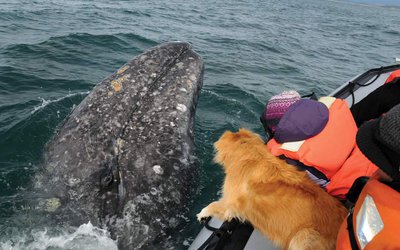
It’s hard to imagine creatures more enigmatic than the gray whales that migrate along the Oregon coast each year. Ever since the ban on the commercial slaughter of gray whales took effect in the 1930s, the species has slowly recovered, and now thousands of these graceful marine mammals make the yearly journey up and down the West Coast, from Alaska to Baja California and back.
Each summer, around 200 whales decide that Oregon is the place to be, and rather than go back to Alaska for the summer, they stop in Oregon and hang out until it’s time to return to Mexico.
So how do summer residents pass the time while they’re here? They get frisky. And at 50 feet long, these cetaceans make a big splash.
“They have sex just for the fun of it,” says gray whale researcher and whale-watching guide Carrie Newell, based in Depoe Bay. She takes tour boats of whale watchers into Oregon coast waters throughout the year.
“Gray whales are very intelligent, and I see them doing it all the time,” she says.
The first thing to know about cetacean sex, Newell says, is that it’s basically year-round. A female gray whale can’t get pregnant until the end of December, so any sex that happens outside of her fertile months is pretty much for practice.
Newell’s research has revealed that gray whales staying in Oregon munch on mysid shrimp — they fast while in Mexico, so once they hit Oregon and regain their energy, they get down to business.
“The end of July and August, and especially September, is when I see a lot of courtship occurring,” Newell says.
These marine mammals weigh 80,000 pounds, and their penises, or “pink floyds,” as Newell calls them, are hot pink and measure 6 feet long. It’s no wonder the gray whale’s scientific name is Eschrichtius robustus.
Unlike humpback whales, gray whales generally don’t fight with each other over females. At times, Newell says, she’s seen them help each other when they’re in a mating triad, with one female and two males. This arrangement is typical among gray whales, as are couplings and other sexual pairings.
Antics include literal tail chasing, rubbing up against one another and much flashing of appendages. This behavior can look odd from the surface, a collusion of flippers, tails and pink floyds.
On one boat tour, Newell says her favorite summer resident, Eagle Eye, put on quite a show. “He’s very friendly, and he has come up to the boat many times,” Newell says. “He’s also very promiscuous.”
She took a tour group out on the waters at 8 am, and Eagle Eye was looking to get off, chasing a female around the bay. When Newell returned with her 10 am tour, he was still at it. But at noon, Eagle Eye was nowhere to be found.
Newell searched and finally found him, sound asleep and bobbing up and down in the water. “I said, ‘Oh, I guess he’s tired,’” she laughs.
Of course, it’s not all about the sex. Female gray whales are loving mothers and nurture their young until weaned at around eight months. They’ve been known to push their babies up to tour boats to allow the baby to get a closer look.
Gray whales can live to be 80 years old, and current threats to the species include habitat degradation, collisions with vessels and entanglement in fishing gear, according to experts.
“They’re just amazing creatures,” Newell says. “Even though we killed so many of them, they’re very friendly animals.”
Carrie Newell offers whale-watching tours in Depoe Bay. For more information, check out oregonwhales.com or call (541) 912-6734.